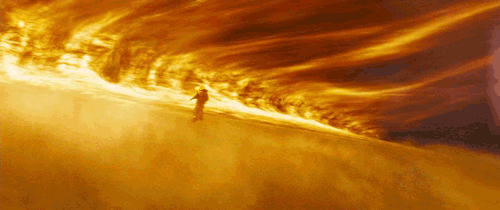 Lightfoot, on 06 May 2015 - 01:30 PM, said:
Lightfoot, on 06 May 2015 - 01:30 PM, said:
I assure you that is not the case. Cold works the same everywhere. Don't plan on any trips to Saturn's moon's with your Bic lighter for heating because there is no atmosphere to transfer the heat away. You'll find you freeze much faster there than Antarctica.
Or have you ever been on a mountain above 15,000 feet? The sun comes out and you are roasting, it goes behind a little white cloud for a few seconds and the temperature drops by 20-30 degrees. In Space the temperature shifts are much more severe where the sunlight side of an object can be 212F while the shadow side is 200 below. Depends on how close to the sun you are of course.
When there is no atmosphere or other material to convect or conduct the heat away from a hot object, it takes a relatively long time for it to leave the system through radiation. Now, I will freeze if you expose me to open vacuum in shadow, but I'm also a A.) only 37 degrees Celsius and B.) a very poor retainer of heat. Even with the amazing heat differential between my temperature and about 3-15 degrees above absolute zero, It's not even close to an instantaneous flash-freeze. It's going to take several [painful] minutes. Furthermore, a planet or other massive celestial body has a large amount of matter in which to sink the heat. So the surface may become hot during the day, but as soon as it stops getting shined on the heat transfers to the cooler inner portions of the crust (or even the core if it isn't molten) with nothing new coming in. The planet is also always radiating heat, which is how it doesn't just become a slag ball. Planet gets exposed to too much energy, and it
does become a slag-ball precisely because it can't get rid of the heat fast enough through radiation to maintain system temperature below freezing levels (note, we're talking about freezing levels for something like iron or nickel). If you could rush air or coolant over it, it could stay cold longer because that's a much more time-efficient form of cooling than radiation.
Here's a website that can teach you all about rocketry and what's necessary to consider for operating in space. Its sections are amalgamations of work and interviews with real-world scientists and engineers in this field. The removal of waste heat in space is a very real problem, especially if you need to do it quickly and without creating a massive combat-related weakness.
Now, the 'Mechs in this game could be conducting the heat through their feet into the ground, but then it would have to be assumed that all 'Mechs have sinks in their legs and we'd all have to benefit from standing in water, too, regardless of the presence of sinks there in the MechLab.



 Spheroid, on 05 May 2015 - 05:25 PM, said:
Spheroid, on 05 May 2015 - 05:25 PM, said:
























